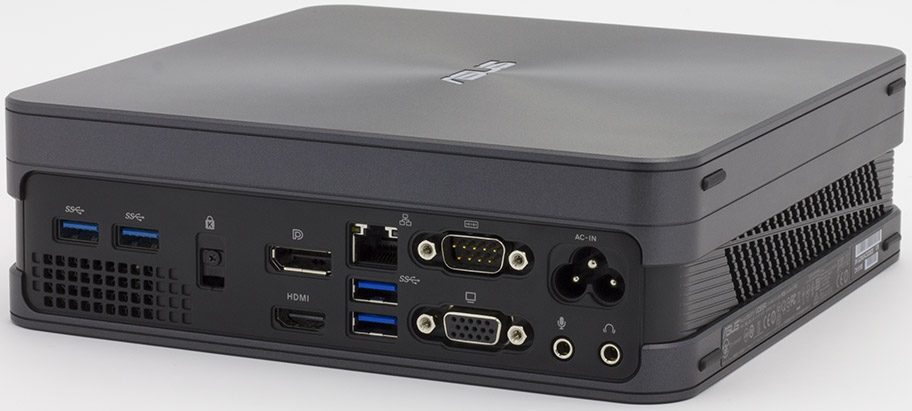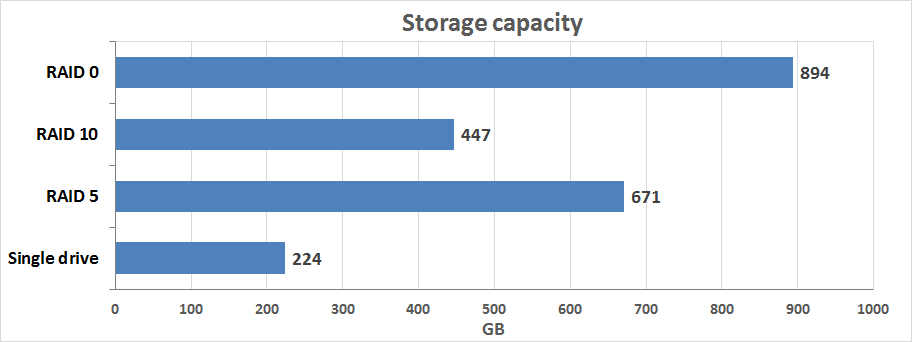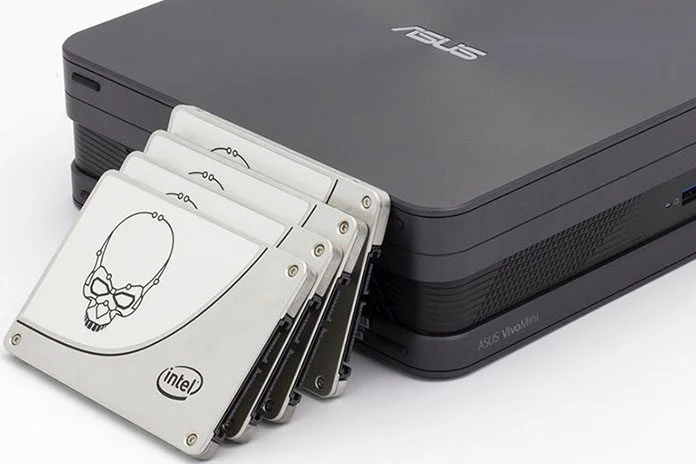The mini-PC scene has exploded in recent years, driven largely by the development of increasingly power-efficient chips that squeeze into tighter spaces with fewer compromises. Desktop-class performance is now available in a much smaller package that’s easy to fit anywhere in the home or workplace.
While modern mini PCs can keep up with the performance of much larger systems, they typically fall short on storage capacity. Most are limited to one or two drives, a fraction of what fits into their desktop counterparts. This restriction diminishes their usefulness for servers and network-attached storage (NAS). In an era where everyday users are generating unprecedented amounts of personal data, from casual selfies to high-resolution videos, it’s even becoming a hindrance for client systems.
External and cloud-based storage can compensate for a lack of internal capacity, but neither is a particularly elegant solution. That’s why we developed the VivoMini VC65R, a mini PC capable of housing up to four drives inside a compact chassis—and combining them in RAID for enhanced performance, failure tolerance, or both. Let’s take a closer look.

At 7.8” x 7.8” x 2.4”, the VC65R occupies a fraction of the space of a conventional PC. Its total volume is just 2.4 liters—and that’s all in. The power supply is integrated into the chassis, so you don’t have to worry about the external bricks and wall warts that come with most mini PCs.
Integrating the PSU adds a little heft, but the VC65R still weighs only 4.8 lbs without drives installed. That’s light enough to hang off the back of a monitor using the included VESA bracket. The system can also lie flat or stand vertically on its left side. Grippy rubber feet prevent slippage in both orientations.
Understated styling lets the VC65R blend into most environments. The concentric circles etched into the lid echo the spun metal finish on our Zen products, while the gray-and-black colorway adds a subtle contrast. We also toned down the brightness of the white LED behind the power button to maintain the muted aesthetic. This little touch is particularly beneficial when using the VC65R as a media PC; the piercing glow of an LED is the last thing you want to see when watching Netflix with the lights turned low.

The VC65R’s unobtrusive nature is more than just skin deep. The system barely whispers at idle, producing just 21 dB. Even when fully loaded, the cooling generates 35 dB, which is quieter than a typical library. You’ll barely notice it’s there.
Power-efficient hardware deserves some of the credit for the inconspicuous acoustic profile, but not because we resorted to pared-down mobile chips. Instead, the system uses desktop-class CPUs from Intel’s 6th Generation Core family, otherwise known as Skylake. The VC65R-G039M variant in the spotlight today is equipped with the Core i5-6400T, a 35W chip with quad cores clocked up to a speed 2.8GHz. This processor has ample horsepower for everything from basic productivity to demanding content creation. Applications load instantly, web pages render in the blink of an eye, and videos encode at warp speed.
The processor’s HD Graphics 530 GPU isn’t a powerhouse, but it still has enough oomph for casual gaming and video playback. Video decoding is accelerated in hardware at resolutions up to 4K, ensuring low CPU utilization—and minimal fan noise—when watching Ultra HD movies.

The GPU drives HDMI and DisplayPort outputs, and it can power a third monitor via VGA. The legacy video out makes the VC65R compatible with any display, while the COM port adds old-school flavor that’s essential for some server applications. For more modern devices, you get dual USB 3.0 ports up front, plus four more around the back. Analog headphone and microphone jacks also populate the rear panel, while a memory card reader resides on the right side of the case. Networking is available in both wired and wireless flavors. In addition to the Gigabit Ethernet jack in the back, there’s an 802.11ac Wi-Fi module with Bluetooth 4.0 support.
A sliding Kensington lock lets you anchor the system in place—and secure the lid to keep the internals safe. Remove the screw, slide down the latch, and you can pop the top to get at the guts.

While the processor is soldered to the motherboard, the VC65R is sold without memory and storage. The barebones configuration makes it easy to tailor the system to suit your needs, whether you want a mini desktop, server, or NAS replacement. Populating the machine requires no more than a screwdriver and the requisite components.
Dual SO-DIMM slots hide behind a removable panel under the drive cage. You can add up to 16GB of DDR3-1600L memory, which is more than enough for heavy lifting. Be sure to install memory in both slots for the best experience. A single SO-DIMM is OK for basic productivity, but the integrated graphics require a dual-channel config for optimal performance.
Storage is housed in a modular cage with room for four 2.5” drives. Each bay is large enough to accept SSDs or hard drives up to 9.5 mm thick, making the VC65R compatible with the vast majority of options available on the market. Installation is as easy as turning a few screws and connecting the included Serial ATA cables, which are trimmed to just the right length to keep things neat and tidy.

SSDs boast faster transfer rates and nearly instantaneous access times that make overall system performance feel much snappier, so they’re the best option for system drives and general desktop use. Hard drives deliver similar capacities at much lower prices, which is preferable if you need to load up on storage without breaking the bank. You can add SSDs and hard drives to the same system, but we don’t recommend combining them in the same RAID array. RAID works best when arrays are built with identical drives.
RAID support is provided by the Intel H170 chipset, which supports RAID 0, 1, 10, and 5 setups. RAID 0 stripes data across multiple drives to maximize performance and capacity, but a single failure will take down the entire array—and all your data—even if the other drives are fine. The rewards are great, but so is the penalty for failure. RAID 1 mirrors data on a second drive to ensure that it’s still accessible if one of them fails, but because data is duplicated, storage is limited to the capacity of a single drive. RAID 10 goes for the best of both worlds by striping and mirroring to boost performance and failure protection simultaneously, while RAID 5 stripes data and calculates parity to provide redundancy. Parity lets RAID 5 maximize storage capacity while still being able to survive a drive failure, but the associated calculations slow write performance.
To get a sense of what to expect from the different options, we loaded the VC65R with four Intel 730 Series 240GB SSDs and ran some benchmarks. Here are the results from CrystalDiskMark with a single drive and four-drive RAID 0, 10, and 5 arrays:

The RAID 0, 10, and 5 arrays all read at around 1600MB/s, more than tripling the speed of a single drive. Read performance is likely bottlenecked by the DMI link between the processor and chipset, which is why it doesn’t scale linearly with the number of drives. Linear scaling is evident with RAID 0 write speeds, which are about four times faster than a single drive. Since write performance is lower overall, it doesn’t hit the same DMI limitation as reads.
RAID 10 nearly doubles the write performance of a single drive, which makes sense if you think of it as a pair of mirrored, two-drive RAID 0 arrays. RAID 5 write performance is barely slower than a single drive due to the overhead associated with parity calculations.
Performance is only one part of the storage equation, so here’s how the arrays stack up in terms of capacity:

What RAID 5 lacks in write performance it makes up here. The four-drive array requires one drive’s worth of storage for parity, leaving 671GB available. RAID 10 has a lower yield, with only 447GB accessible to the user. RAID 0 is the only one to deliver the full capacity of the drives in the array, an advantage tempered by its lack of redundancy.
The failure tolerance of RAID 10 and 5 arrays is critical for server and network-attached storage, where protecting against data loss is more important than maximizing performance and capacity. RAID 10 is better if you write a lot of data, while RAID 5 is more attractive for read-intensive workloads—and where capacity is of primary importance. RAID 0 is only worthwhile if you value performance and capacity over redundancy.
The VC65R is flexible enough to support separate RAID 0 and 1 arrays with two drives apiece. You can also combine a single drive with two- and three-way arrays, a configuration that makes a lot of sense for desktops and media PCs. If I were configuring the VC65R for myself, I’d use a single SSD for the operating system and applications, plus a three-way RAID 5 array of hard drives for media storage and backups.
If you want to put together your own miniature storage monster, the VC65R-G039M is available now for $408.99. Other variants are available outside North America, including one that trades two of the 2.5” bays for a slim optical drive, and another that cuts out those bays to shave half an inch off the height of the chassis.

